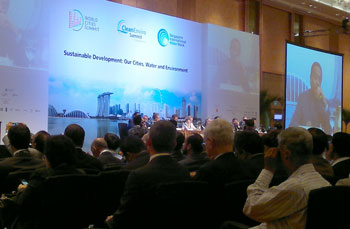 Why should you as a thought leader in another industry care about what’s happening at a water conference in Singapore?
Why should you as a thought leader in another industry care about what’s happening at a water conference in Singapore?
Singapore’s vital water industry makes it one of the world’s most important and influential Hydro Hubs, a reputation enhanced by its sponsorship of the successful Singapore International Water Week, now in its fifth year. With the goal of 11,000 jobs in the water industry in 2015, Singaporeans will benefit from the expected S$1.7 billion that the water industry will add to the GDP by that date.
Read more: Thoughtleaderzone’s Quotable Quotes from Singapore International Water Week (doc)
So water may be blue, but the water industry certainly has a golden touch. There’s money to be made in a field where demand continues to rise and supplies are limited. There’s ”blue gold” in using water more efficiently in any industry to save money and to preserve natural resources, which makes sense if you’re trying to be green. And you are trying to be green, aren’t you?
The second highest consumer of water, following agriculture, is industrial water, which accounts for about 25% of global water demand. Oil and gas, food and beverage, mining and chemical industry sectors contribute to that large statistic. If industrial water users lowered their water footprint every year, if agricultural users lowered theirs, and domestic users went on a ”water diet,” we could secure our water future.
Are you aware of your water footprint at work and at home? Are you reducing it year after year? Are you looking for ways to become a model thought leader of a water-wise company that focuses on environmental, economic and social issues, the ”triple bottom line”? Ask, assess, then act. We’re here to help!

Pingback: Pink Matters, Part 1: Women are still scarce in the C-suite |